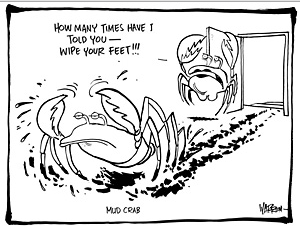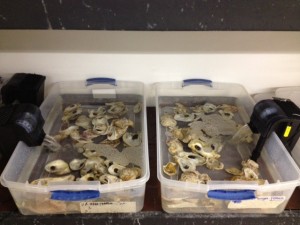STEM Thursday, Spring 2016
Oyster Adaptations
Engage
- I will share my experience over the summer and tell the students the kind of study I was a part of. I will share my PPT via Smart Board, which has video clips and pictures.
Explore
There will be samples of various sizes of oyster shells. Students will be able to pick up and really look at the details of the oyster shells. Students will write down what they observe. Once completed, students will write down some “I wonder” questions. This will be done on the left hand side of their interactive notebook. There will also be some questions that the groups will have to answer:
- Why do you think oysters have thick shells?
- Can you explain how this adaptation helps the organism?
- What do you think the shell is made of?
- What would the outcome be if oyster shells were easy to crack? With the concern of predators.
Explain
Students will complete the vocabulary activity sheet provided to them. There are 4 columns that students will need to fill out; what do you think the word means, the actual definition, illustration, and using it in a sentence. The vocabulary words are: species, adaptation, niche, predator, prey, habitat, and calibrator. Once completed and reviewed with group members, students will trim and glue on a blank left page of their interactive notebook. On the right side of their interactive notebook, students will trim and glue the Eastern Oyster Poster (as seen below). This is a wonderful information sheet that students will go over and will be quizzed as their “out the door pass.” Then using poster paper, groups will each be responsible for teaching the class about their section. They can present it as a comic strip, wanted poster, thinking map…etc. It is required that the new learned vocabulary be used throughout this assignment.
- Group1-Why are oyster reefs important?
- Group2-What are the habitat requirements for oysters?
- Group3-How have oysters adapted to survive?
- Group4-What is filter feeding?
- Group5-What are oysters threatened by?
| Vocabulary
Words |
What do you think it means? | Actual
Definitions |
Illustration | Use in a Sentence |
| Species | ||||
| Adaptations | ||||
| Niche | ||||
| Predator | ||||
| Prey | ||||
| Habitat |
|
|||
| Calibrator |
Elaborate
Math connection- Teaching across the disciplines
- Math Connection~ using the calibrators, students will measure to find the diameter of each oyster shell. Using their interactive notebooks (left side), students will create a data box using a ruler; this is where the shell measurements and average will go. Students must also label their data table. Once all of the measurements have been taken, students will find the average of the oyster shells diameter.
Evaluate
What have we learned about adaptations?
- Students will be given a short quiz using the Smart Board and Mimio Votes. The data from the quiz will be shared with the class, whole group. This is valuable information for the teacher and students. Students will then be given each a sticky note and as their ticket out the door they must write down a fact about the adaptation of oysters that they learned today. The teacher will review and check for understanding.

